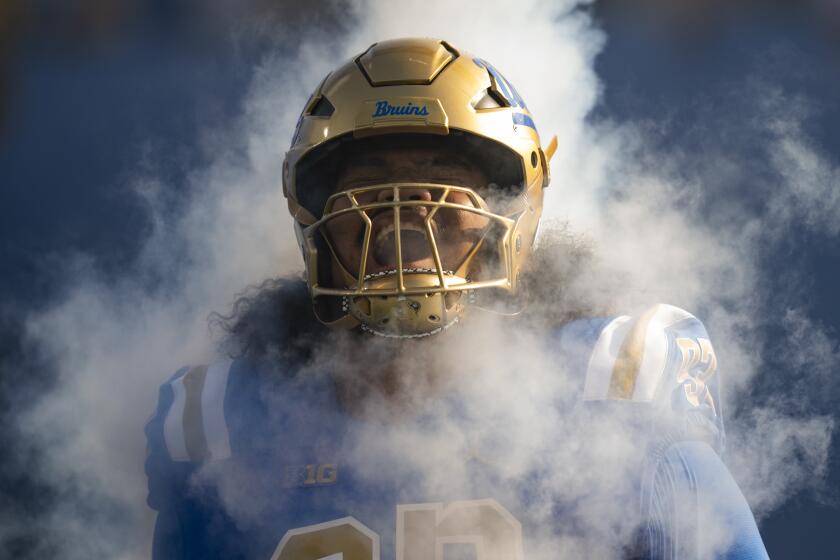
Often it’s his awareness in the seconds before the snap that has turned Carson Schwesinger from zero-star prospect to hero of the UCLA defense.
Scanning the players across the line of scrimmage, he examines body positioning and mannerisms that can provide a tipoff.
Does the offensive tackle place both hands on his thighs? It’s probably going to be a pass.
Does the quarterback lick his hands? He’s probably going to throw the ball.

Does the running back stand a certain way? He’s probably going to take a handoff.
Down and distance enhance the likelihood of one play call over another. Schwesinger runs through the possibilities in his mind. Then he runs to where he thinks the play is going to develop.
“Once the play starts,” Schwesinger said, “you really only have one or two play options that are possible and then you react based off those.”
His instincts are usually right.
In the first five starts of his career, the redshirt junior linebacker has led the Bruins with double-digits tackles each game. Twelve against Louisiana State. Thirteen against Oregon. Fifteen against Penn State. Thirteen against Minnesota. Ten against Rutgers.
“He’s a heat-seeking missile,” fellow Bruins linebacker Kain Medrano said, “just going in there and causing havoc in any way he can.”
Along the way, the former walk-on has emerged as the Big Ten leader with 6.4 solo tackles per game as the Bruins (2-5 overall, 1-4 Big Ten) prepare to face Nebraska (5-3, 2-3) on Saturday at Memorial Stadium in Lincoln. He’s also the first UCLA player to log double figures in tackles in five consecutive games since current Dallas Cowboys veteran Eric Kendricks did so in 2014 on the way to winning the Butkus Award that goes to the nation’s top college linebacker.
UCLA defensive lineman Jay Toia probably could play at any of the nation’s top-ranked programs, but he has his reasons for staying on the Bruins.
His unlikely rise, combined with a perfectionist approach and wholesome demeanor, prompted one teammate to call him “Captain America.” Another went with “Sunshine,” a nod to the similarly blond-haired hero of “Remember the Titans.”
“He’s just one of those guys who does everything right, who does everything for the team,” said UCLA safety Bryan Addison, who came up with the “Captain America” nickname, “and then he comes out here on Saturdays and plays even better.”
It’s what Schwesinger does on every other day of the week that impresses most. Showing up at practice with the attitude that he must prove himself anew every time he steps on the field, Schwesinger reintroduces himself to teammates with another highlight play.
“In his mind, he starts from ground zero every single day,” said defensive coordinator Ikaika Malloe, who has made Schwesinger the centerpiece of his scheme. “That’s a skill set that’s very rare and he understands that the way he made it through this path, it ain’t from taking a day off.”
Maybe that’s the only way to go about things when you’ve been forced to prove yourself from the start.
The brothers had long goofed around playing football in the backyard, even devising creative games while bouncing on the trampoline.
Now it was time for the younger sibling to get serious.
His brother Ethan already enrolled in a flag football league where the minimum age requirement was 6, Carson was only 5. At least that’s what it said on his birth certificate.

Representing the younger son as a year older than he was so that boys could play together meant that Dennis Schwesinger would get to coach them simultaneously.
“I don’t know if this is OK to say or not,” Dennis said with a laugh, “but we weren’t altering his birth certificate to make him younger, we were making him older.”
Carson continued playing with older kids even when he progressed to tackle, no one ever questioning his size or toughness. As he moved from linebacker to defensive end to guard to running back to safety, his father’s words always reverberated in his head.
“You’ve got to get in there and outwork them, outthink them, outperform them,” Dennis had told his son, “until there’s no doubt in anybody’s mind that you should be in there.”
By the time he arrived at Oaks Christian High after a year at Santa Clarita Christian, Schwesinger was almost impossible to keep off the field. He played both ways, starring at safety and slot receiver. He also tended to play hurt, forcing coach Charles Collins to keep a watchful eye on whether the gutsy guy was trying to hide an injury.
Whenever he wasn’t practicing or playing, Schwesinger could often be found immersing himself in another film session.
“He’s what I call a football junkie,” Collins said. “He loves ball — not just football but he the loves the actual part of scheme, so that comes from film study and understanding scheme and anticipation. Being on the other side of the ball, he has a unique advantage because he understands splits, spacing and down and distance and those type of things, which takes him to the play.”

While Schwesinger was indispensable for his high school team, some bad timing limited his college opportunities. His senior year came during the COVID-19 pandemic. College coaches weren’t exactly flocking to campus.
When Chip Kelly, then UCLA’s coach, inquired about linebacker Ethan Calvert, Collins told him to consider Schwesinger. Eventually, Calvert went to Utah and Schwesinger became a Bruin as a walk-on after his only other offer — to a school he can’t remember today — would have required him to pay more in tuition.
“Sure enough it ended up happening that Chip brought him in there,” Collins said, “and right away he saw exactly what I was talking about.”
First impressions were made far away from the spot where he stars today.
As a member of the scout team for special teams, Schwesinger kept making plays.
“He was blocking kicks [in practice] and it was kind of like, what is he doing on the other side?” said Malloe, then the Bruins special teams coordinator and outside linebackers coach. “I should bring him on my side instead of him embarrassing my special teams.”
Working in the shadows, Schwesinger felt encouragement when strength and conditioning coach Keith Belton learned his name and kept tabs on how he was doing. He was also championed by Malloe, who made a similar rise from walk-on to starting safety and linebacker on a Washington team that won a share of the Pac-10 title in 1995.
After never playing as a freshman, Schwesinger had dazzled enough in practice to earn a promotion before his redshirt freshman season in 2022. Near the end of fall training camp, Schwesinger was one of six players whom Kelly called in front of the team before making an announcement.

They were now on scholarship.
In addition to the excitement he felt, Schwesinger also realized the importance of doubling down on his determination.
“When it’s a goal that you’ve worked for and it finally gets there,” he said, “you feel a sense of accomplishment, but also I wanted to keep going.”
Schwesinger appeared in every game in 2022 as a reserve linebacker and on special teams, making a combined 15 tackles. Last season, he reprised that role, making two tackles for loss among his 12 tackles.
A year later, he’s matched or exceeded his 2023 season tackle total in four different games. His ability to predict the play has led to the exponential rise in production given that Malloe said “60% to 70% of the game is won presnap.”
Schwesinger’s special talent is equaled by his capacity to make the tackle once he meets the ballcarrier. This requires knowing the player’s moves — will he try to run him over, spin around him or beat him with a burst of speed?
“He understands not just the fundamentals that we work on,” Malloe said, “but how it applies to a particular guy.”
Malloe’s scheme revolves around his 6-foot-2, 225-pound playmaker, the defensive coordinator doing his best to funnel plays to wherever Schwesinger is on the field. That trust, Schwesinger said, has allowed him to play freer and faster. It also has also helped make the most plays on the team, including two sacks and 6.5 tackles for loss.
“You just kind of get out of his way,” Malloe said. “If you let him be him, then we’re really, really good.”
One of the few times Schwesinger didn’t make the play this season, allowing Minnesota’s Darius Taylor to leak out of the backfield for a last-minute touchdown catch to give the Golden Gophers a victory at the Rose Bowl, Malloe apologized to the linebacker. Malloe said it was his play call that doomed the Bruins.
The Bruins’ rushing attack is last in the country but their running backs have found other ways to influence the game, primarily as receivers and blockers.
At the next practice, Schwesinger wanted to work on correcting the play so that it wouldn’t happen again.
“That’s the part that people don’t see — how intense he is toward being perfect,” Malloe said. “He understands that he won’t [be] but the intensity level and how much he studies film, to me he practices like a professional.”
Schwesinger’s film studies are rivaled only by his dedication to his bioengineering major. While most of his teammates slept, watched movies or chatted on the five-hour flight back from Rutgers, Schwesinger allowed himself a brief respite to finish watching “The Hangover” before shifting to homework in preparation for a midterm.
If a career in pro football doesn’t work out, Schwesinger said, he might develop the next generation of wearable electronics in sports. Maybe he could even create something to help others develop his instincts before a play.
In the meantime, he’ll continue working to remain a central part of UCLA’s defense, even if it may seem as if there’s no displacing him now.
“It doesn’t matter how good you think you are,” Schwesinger said, “you’ve got to make sure that everybody else thinks you’re that good to where they have to put you in.”
More to Read
Go beyond the scoreboard
Get the latest on L.A.'s teams in the daily Sports Report newsletter.
You may occasionally receive promotional content from the Los Angeles Times.








